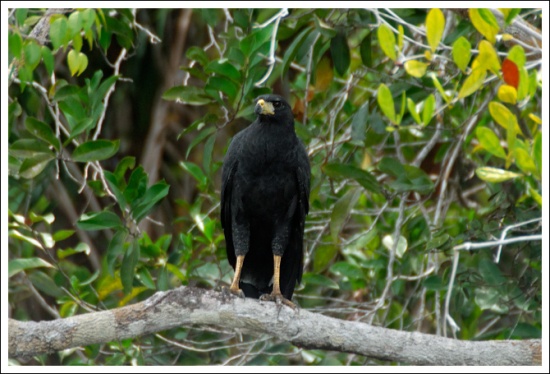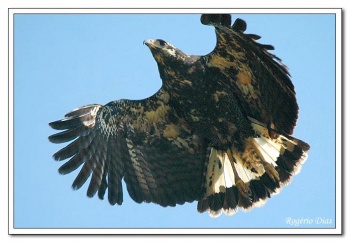Nomdeploom (talk | contribs) |
(Pictures of Immature & Juvenile in flight. Video link) |
||
| Line 1: | Line 1: | ||
{{incomplete}} | {{incomplete}} | ||
| + | [[Image:GreatBlackHawk.jpg|thumb|550px|right|Photo by {{user|Aracari|Aracari}}<br />Igarape Jauari, Serra do Araca State Park, AM,[[Brazil]], January 2007]] | ||
;[[:Category:Buteogallus|Buteogallus]] urubitinga | ;[[:Category:Buteogallus|Buteogallus]] urubitinga | ||
| − | |||
==Identification== | ==Identification== | ||
| − | Almost entirely black with white on the base and the tip of the tail and with yellow legs and cere. Extent of white on tail and color of lores is variable; subspecies ''ridgwayi'' has two white bands on the tail, of which the upper is narrow and often concealed, and slaty lores. This subspecies also often shows some white barring on thighs. | + | Almost entirely black with white on the base and the tip of the tail and with yellow legs and cere. |
| + | |||
| + | Extent of white on tail and color of lores is variable; subspecies ''ridgwayi'' has two white bands on the tail, of which the upper is narrow and often concealed, and slaty lores. This subspecies also often shows some white barring on thighs. | ||
| + | [[Image:Great Black-Hawk 124es.jpg|thumb|300px|right|Immature<br />Photo by {{user|Dave+B+Smith|Dave B Smith}}<br />[[Tobago]], March 2011]] | ||
==Distribution== | ==Distribution== | ||
| − | [[Mexico]] to [[Bolivia]], [[Argentina]], and [[Uruguay]]. | + | [[Central America|Central]] and [[South America]]: found from [[Mexico]] to [[Bolivia]], [[Argentina]], and [[Uruguay]]. |
==Taxonomy== | ==Taxonomy== | ||
| − | + | ====Subspecies==== | |
| + | There are two subspecies<sup>[[#References|[1]]]</sup>: | ||
| + | *''B. u. ridgwayi'': | ||
| + | :*Lowlands of northern [[Mexico]] to western [[Panama]] | ||
| + | *''B. u. urubitinga'': | ||
| + | :*Eastern Panama through [[South America]] to northern [[Argentina]] | ||
==Habitat== | ==Habitat== | ||
Habitats from open country to forest but is normally to be seen near water. | Habitats from open country to forest but is normally to be seen near water. | ||
| + | [[Image:44584gavi oni.jpg|thumb|350px|right|Juvenile<br />Photo by '''[http://www.birdforum.net/member.php?u=44584 Rogerio Araújo Dias]'''<br />Brasília, Brazil]] | ||
==Behaviour== | ==Behaviour== | ||
| + | ==References== | ||
| + | #{{Ref-Clements6thAug11}} | ||
| + | {{ref}} | ||
==External Links== | ==External Links== | ||
{{GSearch|Buteogallus+urubitinga}} | {{GSearch|Buteogallus+urubitinga}} | ||
| − | [[Category:Birds]][[Category:Buteogallus]] | + | <br /> |
| + | {{Video|Great_Black_Hawk}} | ||
| + | |||
| + | [[Category:Birds]][[Category:Buteogallus]] [[Category:Videos]] | ||
Revision as of 22:23, 24 December 2011
| This article is incomplete. This article is missing one or more sections. You can help the BirdForum Opus by expanding it. |
- Buteogallus urubitinga
Identification
Almost entirely black with white on the base and the tip of the tail and with yellow legs and cere.
Extent of white on tail and color of lores is variable; subspecies ridgwayi has two white bands on the tail, of which the upper is narrow and often concealed, and slaty lores. This subspecies also often shows some white barring on thighs.
Distribution
Central and South America: found from Mexico to Bolivia, Argentina, and Uruguay.
Taxonomy
Subspecies
There are two subspecies[1]:
- B. u. ridgwayi:
- B. u. urubitinga:
- Eastern Panama through South America to northern Argentina
Habitat
Habitats from open country to forest but is normally to be seen near water.
Behaviour
References
- Clements, JF. 2011. The Clements Checklist of Birds of the World. 6th ed., with updates to August 2011. Ithaca: Cornell Univ. Press. ISBN 978-0801445019. Spreadsheet available at http://www.birds.cornell.edu/clementschecklist/downloadable-clements-checklist
Recommended Citation
- BirdForum Opus contributors. (2024) Great Black Hawk. In: BirdForum, the forum for wild birds and birding. Retrieved 27 April 2024 from https://www.birdforum.net/opus/Great_Black_Hawk
External Links






